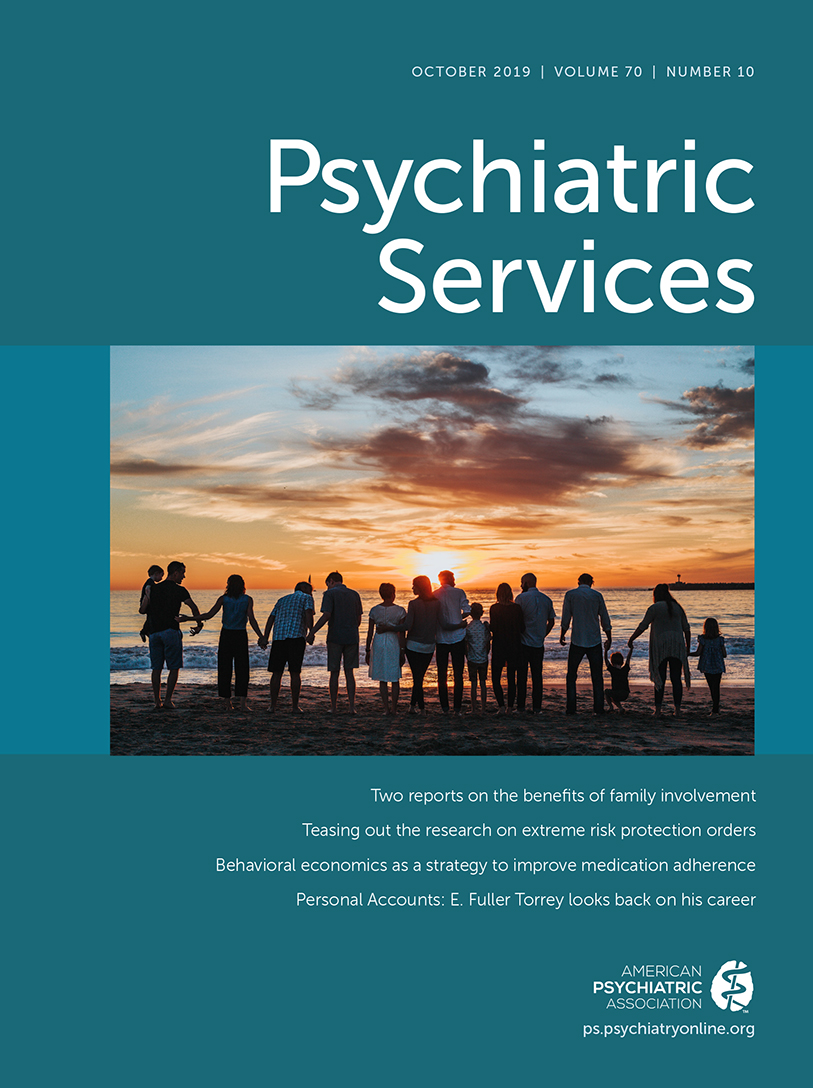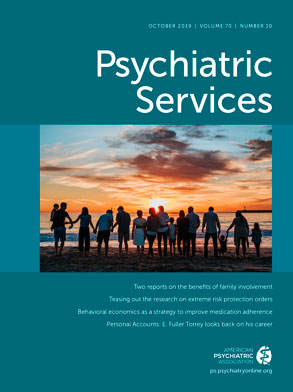More than 30 years of research have demonstrated that the delivery of general medical and behavioral health services in a single setting improves quality of care and reduces health care costs (
1). Health systems are increasingly integrating behavioral health services with primary care (
2). In addition, funders, including the National Institute of Mental Health and Substance Abuse and Mental Health Services Administration, have emphasized the importance of effective integrated behavioral health models.
There is a long and robust history of research on integrated treatments for depression management in primary care, most notably the collaborative care model (
1,
3,
4). Numerous randomized controlled trials and meta-analyses have demonstrated that mild to moderate depression can be effectively managed in a primary care setting (
3,
4). Treating depression in primary care is cost-effective and improves access to care, particularly for patients from traditionally underserved populations (
3,
4). Given the success of integrated behavioral health services in addressing depression in the primary care setting, it is not surprising that integrated care models have been extended and adapted to address a variety of chronic conditions, such as diabetes (
5) and cardiovascular disease (
6).
More recently, there has been interest in extending this proven model to the treatment of substance use disorders (
7). The increasingly high occurrence, morbidity, and mortality associated with alcohol and opioid use disorders among primary care patients have been documented (
8). Specialty addiction services, particularly those that include evidence-based treatment approaches, such as medication-assisted treatment (MAT), are lacking in many locales (
9), underscoring the need to identify alternate treatment approaches with greater reach.
Preliminary work suggests that integrating behavioral health services into primary care for treating alcohol and opioid use disorders is a promising approach (
10,
11). Although barriers to addiction pharmacotherapy, such as buprenorphine waivers, have been well articulated (
7), we currently know little about other barriers in primary care. For example, how do primary care providers view their role with respect to various behavioral health conditions and what is their comfort with MAT? These perspectives are important to understand in order to anticipate potential challenges when implementing and scaling up integrated behavioral health services for substance use disorders in the primary care setting.
We sought to characterize primary care provider screening and treatment practices for opioid use, alcohol use, and depressive disorders. We also assessed provider perceptions about the management of these disorders in primary care. We hypothesized that providers would be more comfortable managing depression, given the long history of effective depression interventions in primary care, and would screen for and treat depression more often than substance use disorders, including alcohol and opioid use disorders, in primary care.
Methods
This project was reviewed by the University of Pennsylvania Institutional Review Board and determined to be exempt. Data were gathered between December 14, 2017, and May 8, 2018, via an anonymous survey of providers administered electronically by using REDCap, a secure, HIPAA-compliant, online survey management application. Participants indicated informed consent on the first page of the survey.
The survey was distributed to primary care service leaders and practice managers of 63 practices in a single large health system in the mid-Atlantic region. Practices included 457 providers and spanned large central metro (N=14, 22%), large fringe metro (N=20, 32%), medium metro (N=28, 44%), and small metro (N=1, 2%) areas (
12). Practices included internal medicine (N=48, 76%), family medicine (N=14, 22%), and student health (N=1, 2%). Practices ranged in size from one to 35 providers and served diverse patient populations, with a varied payer mix. A total of 146 providers in primary care, including physicians, nurse practitioners, and physician assistants, completed the survey, for a 32% response rate.
Survey items queried about provider screening and treatment practices and training, comfort with, and perceived support for managing opioid use, alcohol use, and depressive disorders in primary care. Additional items derived from existing measures assessed perceived norms and behavioral control (
13) and provider burnout (
14). Survey items and response scales are shown in
Table 1.
Results
The mean±SD age of the 146 participants was 45.4±11.8; 34% (N=50) were male and 43% (N=62) female. In the sample, 73% (N=107) endorsed non-Hispanic/Latino ethnicity and 4% (N=6) Hispanic/Latino ethnicity; 70% (N=102) endorsed white/Caucasian race, 3% (N=5) Asian, 1% (N=2) black/African American, 1% (N=2) Native Hawaiian/other Pacific Islander, and 1% (N=1) American Indian/Alaska Native. Twenty-three percent (N=34) did not disclose their gender, race, or ethnicity. Sixty-three percent (N=92) were physicians, 16% (N=23) nurse practitioners, and 3% (N=4) physician assistants; and 18% (N=27) did not disclose their professional role. On average, providers had earned their highest degree 18.9±11.7 years earlier and had worked in their present practice 10.2±9.8 years. Practice data were missing for 32 individuals. Of the 114 individuals who provided practice data, 59% (N=67) were from internal medicine practices, 34% (N=39) from family medicine, and 7% (N=8) from student health. Forty-seven percent (N=54) practiced in a large central metro area, 21% (N=24) in a large fringe metro area, 30% (N=34) in a medium metro area, and 2% (N=2) in a small metro area.
Table 1 presents means and SDs for survey items and results of one-way analysis of variance (ANOVA) tests. ANOVAs with post hoc Tukey’s test were conducted to examine mean differences among responses for opioid use, alcohol use, and depressive disorders. Regarding practice behavior, providers reported differential screening activities by disorder (F=7.3, df=2, 414, p=0.001). They were significantly less likely to screen for opioid use disorders (mean=4.6, p=0.001) and alcohol use disorders (4.8, p=0.03), compared with depression (5.2) (possible scores range from 1 to 6 [and 1 to 7 for some items], with higher scores indicating greater likelihood and confidence). Providers also reported differential treatment practices by disorder (F=125.5, df=2, 405, p<0.001). They were significantly less likely to prescribe medication to treat opioid use disorders (mean=3.2, p<0.001) and alcohol use disorders (3.4, p<0.001), compared with depression (5.6).
Provider confidence varied by disorder (F=142.2, df=2, 402, p<0.001). Providers reported lower confidence managing pharmacotherapy for opioid use disorders (mean=3.4, p<0.001) and alcohol use disorders (3.6, p<0.001), compared with depression (6.4). Similarly, providers reported feeling less prepared, in terms of training and education, to treat opioid use disorders (mean=2.9, p<0.001) and alcohol use disorders (2.7, p<0.001), compared with depression (5.3).
Providers reported that other providers “with practices like mine” were less likely to treat opioid use disorders (mean=2.7, p<0.001) and alcohol use disorders (2.8, p<0.001), compared with depression (5.4) (F=221.9, df=2, 402, p<0.001). Compared with the appropriateness of treating depression in primary care (mean=5.7), providers reported being less sure of the appropriateness of treating opioid use disorders (3.8, p<0.001) and alcohol use disorders (4.0, p<0.001) (F=73.4, df=2, 399, p<0.001). In addition, providers reported that they were less able to navigate community resources for their patients with opioid use disorders (mean=3.7, p<0.001) and alcohol use disorders (3.7, p<0.001), compared with their patients with depression (4.4) (F=11.4, df=2, 396, p<0.001). In all cases, reports for opioid and alcohol use disorders did not differ significantly from one another.
Across disorders, providers reported that having mental health providers in their clinics would allow them to more effectively treat patients. Provider burnout in this sample was relatively low. Finally, providers reported perceiving a moderate to high level of support from leaders and peers to screen for and treat behavioral disorders.
Discussion and Conclusions
In our sample of 146 primary care providers, participants were significantly more comfortable managing depression, compared with opioid and alcohol use disorders. This is not surprising given the attention that depression screening and care management have received in primary care relative to other behavioral health conditions (
15). Given the preponderance of substance use disorders among primary care patients (
8), increased attention to equipping primary care providers to screen for and treat these conditions is warranted. Providers in our survey reported that they lacked training and resources to support the effective management of substance use disorders, despite previous calls to action to increase the scope of primary care practice to include management of these conditions (
15). In addition to training primary care providers in the use of MAT for alcohol use disorders (i.e., topiramate, acamprosate, disulfiram, and naltrexone) and opioid use disorder (i.e., naltrexone and buprenorphine/naloxone), it will also be important to continue to explore the added benefits of integrating care managers and behavioral health providers with substance use expertise into primary care clinics and to remove or minimize obstacles to treatment, such as the requirement that practitioners obtain a waiver to prescribe or dispense buprenorphine.
This study was strengthened by its diverse sample of providers and incorporation of validated measurement strategies (
13,
14). Nevertheless, the study had some limitations. Providers were drawn from a single health system, and results may not generalize to other systems. Our response rate was 32%. Our sample included providers from a range of geographic areas and from both internal medicine and family medicine practices, which strengthens generalizability. However, more providers were from large central metropolitan areas and family medicine practices than would be expected on the basis of the distribution of practices in the network. Future studies with higher response rates will be important to ensure that results are representative of a wide range of provider perspectives.
These results suggest that primary care providers may be less likely to treat alcohol and opioid use disorders, compared with depression, at least in part because they do not believe they have been adequately trained to do so. On the basis of these findings, the following recommendations are offered to advance research and clinical practice. First, it will be important to identify the core training components in behavioral health for primary care providers. Research is also needed to determine the most effective strategies for training learners at various stages of their careers in efficacious behavioral health practices. Second, it will be important to explore collaborative or integrated service models that include behavioral health providers with expertise in treating individuals with substance use conditions. Third, it will be necessary to identify the most effective and critical treatment components of interventions for substance use disorders in primary care in order to promote the development of scalable treatment models for this population. Finally, strategies for leveraging provider norms and improving self-efficacy around behavioral health interventions should be further explored.
Acknowledgments
The authors thank the team from the National Center for Integrated Behavioral Health, Perelman School of Medicine, University of Pennsylvania, for administrative support and ongoing feedback.

